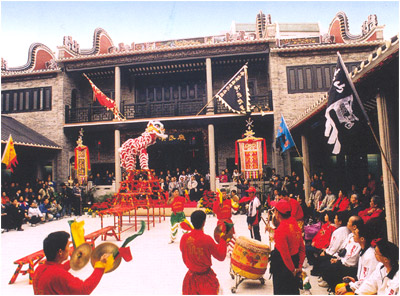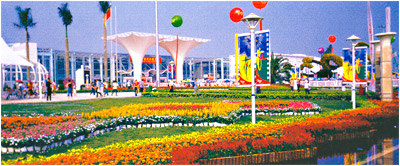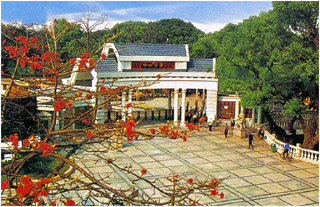-
Physical geography
Foshan, located at south-central Guangdong --the Pearl River Delta hinterland, is an ancient and young city. Owing to itssuperior geographic location, Foshan is to the west of Guangzhou, adjoins Zhaoqing,Zhuhai and Qingyuan, respectively, and is close to Hong Kong and Macao. Thereare Xi River, Bei River and their tributaries running through it. The terrainof Foshan slopes gently, most of them are alluvial plains, which is criss-crossedby rivers and canals and densely covered with fishponds and rich soil. Thenatural resources are mainly composed of pottery clay, rock, glass sand, raremetal, pond fish, paddy rice, sugarcane as well as a variety of fruits andflowers, etc.
Foshan governs five county-level districts, whichare Chancheng, Nanhai, Shunde, Gaoming and Sanshui, with a total area of3,848.49 sq. km. In 2013, its permanent population has reached to 7.2957million.

Foshan, with a long history and numerous scenicspots and historical sites, is a famous national historical and cultural city.The historic sites in Foshan comprise Foshan Ancestral Temple, known as a grandview garden of architecture and sculpture arts, Liangyuan, which is one of thefour famous gardens in Guangdong, etc. In addition, the autumn tints in Foshanand handcrafts are also full of south China features. There are many localspecialties in Foshan too, such as Manggong Cake, Liantang Kudzu and HeyanWhite Gourd, etc.
?The weather is mild and the rainfall is abundantin Foshan due to the subtropical monsoonhumid climate. The annual average temperature is 22.5°C. The coldest month is January, with an average temperatureof 13.9°C, while the hottest month is July, with anaverage temperature of 29.2°C. The annualrainfall is 1,681.2 mm, and 1688.7 mm in Sanshui district, 1677.4 mm in Nanhaidistrict, 1677.6 in Shunde district separately. Foshan has 146.5 average annualrainfall days, while more in the west and north of Foshan because of theorographic lifting effect. The rainy season is from April to September, with80% of the total annual rainfall. The distribution of precipitation is uneven insummer, which always result in the droughts and floods. The rainfall decreaseobviously in autumn and winter. The annual total sunshine duration is about1,630 hours, which results in a long crop growing season.
Because of the low latitude of Foshan and theinfluences of both the marine and terrestrial weather systems, the alternationbetween winter and summer monsoons is a prominent feature of Foshan’s monsoon climate, which means that the northerly windprevails in winter and spring while southerly wind in summer. The northerlywind in winter is dry and cold owing to the southward stretching of polarcontinental air mass, while the southerly wind in summer is warm and humid as aresult of the northward expansion of tropical marine air mass.?Winter
The northeasterly wind and north wind prevail inwinter of Foshan, but the cole and dry air mass is not that cold because oflong distance travel from the source region. Meanwhile, the original cold anddry air mass gradually became cold and humid with the increasing surface airtemperature, the air pressure decreased when it reached Guangdong, so the windspeed gradually decreases from north to south as well. In the arms of winter,we have a feeling of neither entirely bitter coldness, nor complete depressionand sorrow. However, there are some exceptions. Frosty weather may appear asthe cold wave creeps in.. Winter is the dry season of Foshan, with lessprecipitation and adequate sunshine. January is the coldest month, with a meanmonthly temperature of 13.9°C. And theextremely minimum temperature reached to -1.9°C in Jan. 17, 1967.
Spring

The temperature and precipitation both increase inspring. The weather is instability because of the alternative cold and warmweather. The spring of Foshan is always overcast and rainy with chilly windsfrom the statistic of previous years. “Continuousspring rain wets kapoks.” The rainin this season is “joyful yet worrying”. Although it can moisturize the creations and cleans theair, it covers the sunshine as well. Therefore, sunshine duration is the least inthis season, so It's chilly sometimes because of the absence of the sunshineand the small diurnal variation of air temperature. Certainly, the beautifulspring scenes may also appear in some years. Besides, persistent droughts mayarise due to the delayed rainy season in some years. Generally, the rainyseason starts from April, and the pre-rainy season begins.
Summer
Southerly wind prevails in summer affected by themarine air mass which brings plentifulmoisture within the air to Foshan, providing favorable conditions for summerrainfall. May and June are the peak rainfall period of Foshan’s pre-rainy season, with a high possibility of torrentialrainfall. Meanwhile, the period affected by the tropical cyclones is mainlyfrom June to October. According to the statistics, there are around 5 to 6tropical cyclones influence Guangdong each year, and 3 to 4 landing inGuangdong, which is 40% of the number of tropical cyclones landing in China.Therefore, summer is a season with severe thunderstorms and tropical cyclones. Thetotal rainfall in this season is 50% of the annual year's rainfall, which is accompaniedwith strong wind, and often causes severe disasters. However, people are alwayslooking forward to the rainfall. The summer lasts long, with high temperature.July is the hottest month, with the monthly mean temperature of 29.2°C. The extremely maximum temperature once reached up to 39.2°C (July 18, 2005, Nanhai District). With the addition of the highrelative humidity, the summer heat appears to be more oppressive. Therefore, therainfall, with cool breezes, is the best gift of the nature when people arelooking forward to it, which takes awaythe hotness and moisturize numerous people's hearts.
Autumn

Waving good-byes to the hot summer, we step into thecool autumn.The sky is high; the clouds are pale. Autumn is the mostcomfortable season in Foshan. The cold air mass starts to move southward frequently,and the air temperature drops gradually, the cool wind cleanse all depressionsand refreshes everyone.
Autumn is not a season with active tropicalcyclones. But a tropical cyclone is still possible to appear. Averagely, there maybe a tropical cyclone landing in Guangdong every 10 years, with strong wind andtorrential rain. In general, autumn is dominated by fine days with lessprecipitation. According to statistics, from the late September to the end ofNovember, the average rainfall is 155.1mm only, accounting for about 9% of theannual rainfall. There appeared 30 consecutive rainless days more than once inhistory. The autumn dryness is broadly apparent.
Air temperature
The annual average temperature in Foshan isbetween 22.2°C to 22.7°C from the north to the south with a difference of only 0.5°C. In 2007, the annual average temperature reached the highest,with a temperature of 23.8°C.
Winter is the coldest season of the year. Fromthe north to the south, the annual average temperature ranges from 14.4°C to 15.2°C. Inspring, the temperature rises up to 18.0°C. As summer comes, the weather becomes hot, with the annualtemperature of 28.8°C, and there is almost no difference about thetemperature between the north and the south regions. The annual temperature dropsback to 24.2°C in autumn.
The daily range of the air temperature
The difference between the highest and the lowestair temperature in a whole day is defined as the daily range. In autumn andwinter, the daily range is larger than that in spring and summer. Over theyears, the average daily range of each season is 6.2°C in spring, 7.0°C insummer, 7.5°C in autumn and 7.0°C in winter. The highest daily range of the year exists in November,which reaches to 8.0°C, while the lowest is only 6.0°C in March and April.
The regional distribution of extremelytemperature
The extremely maximum temperature is 38.7°C in south, 39.2°C in central region, and39.1°C innorth. The number of days with daily maximum temperature which is no less than 35°C is 21.5 days in north,21.2 days in central region, and 19.0 days in south averagely. The number ofdays with daily minimum temperature less than 5°C is 5.3 days in north,3.8 daysin central region and 3.1 days in south.
If the winter is defined by the 5-day averagetemperature which is lower than 10°C, summeris higher than 22°C, and the spring and autumn is between 10°C and 22°C, thenthe spring and autumn are so short in Foshan while the summer is so long, andthere is no winter in terms of climate here.
Rainfall
The average annual rainfall is 1681.2 mm inFoshan.
The rainfall begin to increase in April. Thefirst rainy season is from April to June, which is defined as the pre-rainyseason, and the low troughs with fronts are the main system to bring therainfall, the average precipitation amount is 718.3 mm, which is 43% of theannual rainfall. The second rainy season is from July to September, which isdefined as the after-rainy season. The main precipitation system is tropicalcyclones and tropical convergence zone. The average rainfall is 626.7 mm,accounting for 37% of the annual rainfall. The rainfall begin to decreasesharply in October.
The annual rainfall days is 146.4, and the northis more than the south region.
Sunlight
The annual average sunshine duration of Foshan is 1,619.4 hours,and the duration of the south exceeds that of the north. The sunshine durationreached the highest in 1963 , with that of 2,433.5 hours, while the lowest sunshineduration appeared in 1997, which is only 1150.4 hours.
Relativehumidity
The annual average relative humidity is 76%. The relativehumidity is low in winter, owing to the dry continental air mass while it reachedto the highest of the year in spring, because the south air becomes active and thewater vapor from sea is continuously delivered to Foshan. In summer, although thesouth moisture air is still active, containing abundant water vapor, itsrelative humidity is lower than that in spring due to the higher temperature. WhenFoshan was invaded by the north cold air in winter, the moisture in the airdecreases gradually, so does the relative humidity correspondingly.
Tropicalcyclone
Tropical cyclone, originated in the tropical ocean, is arapidly rotating clockwise atmospheric vortex. It can be classified into severalcategories according to the air speed near the tropical cyclone center.The tropicalcyclone affecting Guangdong Province comes from the Western Pacific Ocean andthe South China Sea. The main period that tropical cyclone affects Guangdong isfrom June to October each year. In this period, the affecting times of tropicalcyclone accounts for more than 89% of the total of the whole year.
According to the statistics, Foshan is affectedby tropical cyclone 1-2 times each year averagely, and the affected period ismainly between April to December. The earliest typhoon landed in Longlou,Wenchang, Hainan province on April 18, 2008, and relanded on 19, April inDongyang, Yangjiang, there was a gust wind leveled 8 to 9 in Foshan, which didn'tbrought too much disasters to Foshan . July is the month with the highest ratethat tropical cyclone affects Foshan, and followed by August. From July toSeptember, the times of being affected by tropical cyclone cover 75% of thetotal of the year.
?????








